An Integrative Analysis of Transcriptome, Proteome and Hormones Reveals Key Differentially Expressed Genes and Metabolic Pathways Involved in Flower Development in Loquat
Abstract
1. Introduction
2. Results
2.1. Morphological Characterization of Flower Development
2.2. Sequencing, Assembly, and Functional Annotation
2.3. Analysis of Differentially Expressed Genes (DEGs)
2.4. Analysis of Key Differentially Expressed Genes (DEGs) Involved in Pathways of Hormone Signal Transduction
2.5. Identification of Flowering Pathway-Related Genes and Transcription Factors (TFs)
2.6. Proteomic Analysis and Identification of Differentially Accumulated Proteins (DAPs)
2.7. Key Gene Cross-Talk Between the Protein and Transcription Levels
2.8. Validation of the Expression Levels of Several Key Flower Development-Related Genes
2.9. Measurements of Endogenous GA3, zeatin (ZT), and ABA Concentrations
3. Discussion
3.1. Illumina Sequencing in Flower Development of Loquat
3.2. Key Genes of TFs and Floral Integrators Associated with Flower Development
3.3. Expression Analysis of Key Differentially Expressed Genes (DEGs) Involved in Plant Hormone Signal Transduction Pathways
3.4. Key DEGs and DAPs Involved in Starch and Sucrose Metabolism Pathways
4. Materials and Methods
4.1. Plant Materials
4.2. RNA Extraction and Construction of cDNA Library
4.3. Data Filtering, de novo Assembly, and Annotation
4.4. Identification of Differentially Expressed Genes (DEGs) and Transcription Factors (TFs)
4.5. Protein Extraction and Digestion
4.6. Protein Digestion and TMT Labeling
4.7. Low pH nano-LC–MS/MS Analysis
4.8. LC–MS/MS Analysis
4.9. Bioinformatics Analysis of Proteomic Data
4.10. Validation Analysis of Transcriptome Data by qRT-PCR
4.11. Determination of GA3, ZT, and ABA Concentrations
5. Conclusions
Supplementary Materials
Author Contributions
Funding
Conflicts of Interest
Abbreviations
| DEGs | Differentially expressed genes |
| GAs | Gibberellins |
| ABA | Abscisic acid |
| FBD | Flower bud differentiation |
| FBE | Floral bud elongation |
| FA | Floral anthesis |
| FT | FLOWERING LOCUS T |
| SOC1 | SUPPRESSOR OF OVEREXPRESSION OF CONSTANS 1 |
| SPL | SQUAMOSA PROMOTER BINDING LIKE |
| LFY | LEAFY |
| AP1 | APETALA1 |
| TFs | Transcription factors |
| Nr database | Non-redundant database |
| GO | Gene Ontology |
| KEGG | Kyoto Encyclopedia of Genes and Genomes |
| JA | Jasmonic acid |
| SA | Salicylic acid |
| VRN1 | VERNALIZATION 1 |
| VIN2 | VERNALIZATION-INDEPENDENT INSENSITIVE 2 |
| EMF2 | EMBRYONIC FLOWER 2 |
| DCL | DICER-LIKE |
| LHY | LATE ELONGATED HYPOCOTYL |
| PHYB | PHYTOCHROME B |
| WOX | WUSCHEL-related homeobox |
| PI | PISTILLATA |
| AGL | AGAMOUS-Like |
| SEP | SEPALLATA |
| TFs | Transcription factors |
| DAPs | Differentially accumulated proteins |
| FPKM | Fragments per kilobase per million |
| ZT | Zeatin |
| FDR | False discovery rate |
References
- Lin, S.; Sharpe, R.H.; Janick, J. Loquat: Botany and horticulture. Hortic. Rev. 1999, 23, 233–269. [Google Scholar]
- Reig, C.; Gil-Muñoz, F.; Vera-Sirera, F.; García-Lorca, A.; Martínez-Fuentes, A.; Mesejo, C.; Pérez-Amador, M.A.; Agustí, M. Bud sprouting and floral induction and expression of FT in loquat [Eriobotrya japonica (Thunb.) Lindl.]. Planta 2017, 246, 915–925. [Google Scholar] [CrossRef]
- Chen, W.; Wang, P.; Wang, D.; Shi, M.; Xia, Y.; He, Q.; Dang, J.; Guo, Q.; Jing, D.; Liang, G. EjFRI, FRIGIDA (FRI) ortholog from Eriobotrya japonica, delays flowering in Arabidopsis. Int. J. Mol. Sci. 2020, 21, 1087. [Google Scholar] [CrossRef]
- Bäurle, I.; Dean, C. The timing of developmental transitions in plants. Cell 2006, 125, 655–664. [Google Scholar] [CrossRef]
- Ortizmarchena, M.I.; Albi, T.; Lucasreina, E.; Said, F.E.; Romerocampero, F.J.; Cano, B.; Ruiz, M.T.; Romero, J.M.; Valverde, F. Photoperiodic control of carbon distribution during the floral transition in Arabidopsis. Plant Cell 2014, 26, 565–584. [Google Scholar] [CrossRef]
- Komeda, Y. Genetic regulation of time to flower in Arabidopsis thaliana. Annu. Rev. Plant Biol. 2004, 55, 521–535. [Google Scholar] [CrossRef]
- Cho, L.H.; Yoon, J.; An, G. The control of flowering time by environmental factors. Plant J. Cell Mol. Biol. 2017, 90, 708–719. [Google Scholar] [CrossRef] [PubMed]
- Fornara, F.; de Montaigu, A.; Coupland, G. SnapShot: Control of flowering in Arabidopsis. Cell 2010, 141, 550, 550.e1–550.e2. [Google Scholar] [CrossRef]
- Andrés, F.; Coupland, G. The genetic basis of flowering responses to seasonal cues. Nat. Rev. Genet. 2012, 13, 627–639. [Google Scholar] [CrossRef] [PubMed]
- Kim, D.H.; Doyle, M.R.; Sung, S.; Amasino, R.M. Vernalization: Winter and the timing of flowering in plants. Annu. Rev. Cell Dev. Biol. 2009, 25, 277. [Google Scholar] [CrossRef] [PubMed]
- Srikanth, A.; Schmid, M. Regulation of flowering time: All roads lead to Rome. Cell. Mol. Life Sci. 2011, 68, 2013–2037. [Google Scholar] [CrossRef] [PubMed]
- Kumar, S.V.; Lucyshyn, D.; Jaeger, K.E.; Alós, E.; Alvey, E.; Harberd, N.P.; Wigge, P.A. PHYTOCHROME INTERACTING FACTOR4 controls the thermosensory activation of flowering. Nature 2012, 484, 242. [Google Scholar] [CrossRef]
- Torti, S.; Fornara, F.; Vincent, C.; Andrés, F.; Nordström, K.; Göbel, U.; Knoll, D.; Schoof, H.; Coupland, G. Analysis of the Arabidopsis shoot meristem transcriptome during floral transition identifies distinct regulatory patterns and a leucine-rich repeat protein that promotes flowering. Plant Cell 2012, 24, 444–462. [Google Scholar] [CrossRef]
- Turck, F.; Fornara, F.; Coupland, G. Regulation and identity of florigen: FLOWERING LOCUS T moves center stage. Annu. Rev. Plant Biol. 2008, 59, 573–594. [Google Scholar] [CrossRef] [PubMed]
- Melzer, S.; Lens, F.; Gennen, J.; Vanneste, S.; Rohde, A.; Beeckman, T. Flowering-time genes modulate meristem determinacy and growth form in Arabidopsis thaliana. Nat. Genet. 2008, 40, 1489–1492. [Google Scholar] [CrossRef] [PubMed]
- Blázquez, M.A.; Ferrándiz, C.; Madueño, F.; Parcy, F. How Floral Meristems are Built. Plant Mol. Biol. 2006, 60, 855–870. [Google Scholar] [CrossRef] [PubMed]
- Mandel, M.A.; Yanofsky, M.F. A gene triggering flower formation in Arabidopsis. Nature 1995, 377, 522–524. [Google Scholar] [CrossRef]
- Khan, M.R.G.; Ai, X.Y.; Zhang, J.Z. Genetic regulation of flowering time in annual and perennial plants. Wiley Interdiscip. Rev. RNA 2014, 5, 347–359. [Google Scholar] [CrossRef]
- Krizek, B.A.; Fletcher, J.C. Molecular mechanisms of flower development: An armchair guide. Nat. Rev. Genet. 2005, 6, 688–698. [Google Scholar] [CrossRef]
- Casal, J.J.; Fankhauser, C.; Coupland, G.; Blázquez, M.A. Signalling for developmental plasticity. Trends Plant Sci. 2004, 9, 309–314. [Google Scholar] [CrossRef]
- Wu, J.; Xu, Z.; Zhang, Y.; Chai, L.; Yi, H.; Deng, X. An integrative analysis of the transcriptome and proteome of the pulp of a spontaneous late-ripening sweet orange mutant and its wild type improves our understanding of fruit ripening in citrus. J. Exp. Bot. 2014, 65, 1651–1671. [Google Scholar] [CrossRef]
- Pan, Z.; Zeng, Y.; An, J.; Ye, J.; Xu, Q.; Deng, X. An integrative analysis of transcriptome and proteome provides new insights into carotenoid biosynthesis and regulation in sweet orange fruits. J. Proteom. 2012, 75, 2670–2684. [Google Scholar] [CrossRef]
- Jiang, S.; Luo, J.; Xu, F.; Zhang, X. Transcriptome analysis reveals candidate genes involved in Gibberellin-induced fruit setting in triploid loquat (Eriobotrya japonica). Front. Plant Sci. 2016, 7, 1924. [Google Scholar] [CrossRef] [PubMed]
- Song, H.; Zhao, X.; Hu, W.; Wang, X.; Shen, T.; Yang, L. Comparative transcriptional analysis of loquat fruit identifies major signal networks involved in fruit development and ripening process. Int. J. Mol. Sci. 2016, 17, 1837. [Google Scholar] [CrossRef] [PubMed]
- Fan, Z.; Li, J.; Li, X.; Wu, B.; Wang, J.; Liu, Z.; Yin, H. Genome-wide transcriptome profiling provides insights into floral bud development of summer-flowering Camellia azalea. Sci. Rep. 2015, 5, 9729. [Google Scholar] [CrossRef]
- Guo, X.; Yu, C.; Luo, L.; Wan, H.; Li, Y.; Wang, J.; Cheng, T.; Pan, H.; Zhang, Q. Comparative transcriptome analysis of the floral transition in Rosa chinensis ‘Old Blush’ and R. odorata var. gigantea. Sci. Rep. 2017, 7, 6068. [Google Scholar] [CrossRef] [PubMed]
- Liu, K.; Feng, S.; Pan, Y.; Zhong, J.; Chen, Y.; Yuan, C.; Li, H. Transcriptome analysis and identification of genes associated with floral transition and flower development in sugar apple (Annona squamosa L.). Front. Plant Sci. 2016, 7, 1695. [Google Scholar] [CrossRef] [PubMed]
- Wigge, P.A.; Kim, M.C.; Jaeger, K.E.; Busch, W.; Schmid, M.; Lohmann, J.U.; Weigel, D. Integration of spatial and temporal information during floral induction in Arabidopsis. Science 2005, 309, 1056–1059. [Google Scholar] [CrossRef] [PubMed]
- Abe, M.; Kobayashi, Y.; Yamamoto, S.; Daimon, Y.; Yamaguchi, A.; Ikeda, Y.; Ichinoki, H.; Notaguchi, M.; Goto, K.; Araki, T. FD, a bZIP protein mediating signals from the floral pathway integrator FT at the shoot apex. Science 2005, 309, 1052–1056. [Google Scholar] [CrossRef] [PubMed]
- Ferrándiz, C.; Gu, Q.; Martienssen, R.; Yanofsky, M.F. Redundant regulation of meristem identity and plant architecture by FRUITFULL, APETALA1 and CAULIFLOWER. Development 2000, 127, 725. [Google Scholar]
- Xu, M.; Hu, T.; Zhao, J.; Park, M.Y.; Earley, K.W.; Wu, G.; Yang, L.; Poethig, R.S. Developmental functions of miR156-Regulated SQUAMOSA PROMOTER BINDING PROTEIN-LIKE (SPL) genes in Arabidopsis thaliana. PLoS Genet. 2016, 12, e1006263. [Google Scholar] [CrossRef] [PubMed]
- Jofuku, K.D.; den Boer, B.G.W.; Montagu, M.V.; Okamuro, J.K. Control of Arabidopsis flower and seed development by the homeotic gene APETALA2. Plant Cell 1994, 6, 1211–1225. [Google Scholar] [PubMed]
- Okamuro, J.K.; Szeto, W.; Lotys-Prass, C.; Jofuku, K.D. Photo and hormonal control of meristem identity in the Arabidopsis flower mutants apetala2 and apetala1. Plant Cell 1997, 9, 37–47. [Google Scholar] [PubMed]
- Balanza, V.; Martinez-Fernandez, I.; Sato, S.; Yanofsky, M.F.; Kaufmann, K.; Angenent, G.C.; Bemer, M.; Ferrandiz, C. Genetic control of meristem arrest and life span in Arabidopsis by a FRUITFULL-APETALA2 pathway. Nat. Commun. 2018, 9, 565. [Google Scholar] [CrossRef]
- Jiang, Y.; Peng, J.; Wang, M.; Su, W.; Gan, X.; Jing, Y.; Yang, X.; Lin, S.; Gao, Y. The role of EjSPL3, EjSPL4, EjSPL5, and EjSPL9 in Regulating Flowering in Loquat (Eriobotrya japonica Lindl.). Int. J. Mol. Sci. 2019, 21, 248. [Google Scholar] [CrossRef]
- Jiang, Y.; Peng, J.; Zhu, Y.; Su, W.; Zhang, L.; Jing, Y.; Lin, S.; Gao, Y. The role of EjSOC1s in flower initiation in Eriobotrya japonica. Front. Plant Sci. 2019, 10, 253. [Google Scholar] [CrossRef]
- Liu, X.; Anderson, J.; Pijut, P.M. Cloning and characterization of Prunus serotina AGAMOUS, a putative flower homeotic gene. Plant Mol. Biol. Rep. 2010, 28, 193–203. [Google Scholar] [CrossRef]
- Lu, S.; Du, X.; Lu, W.; Chong, K.; Meng, Z. Two AGAMOUS-like MADS-box genes from Taihangia rupestris (Rosaceae) reveal independent trajectories in the evolution of class C and class D floral homeotic functions. Evol. Dev. 2007, 9, 92–104. [Google Scholar] [CrossRef]
- Ma, J.; Shen, X.; Liu, Z.; Zhang, D.; Liu, W.; Liang, H.; Wang, Y.; He, Z.; Chen, F. Isolation and characterization of AGAMOUS-Like genes associated with double-flower morphogenesis in Kerria japonica (Rosaceae). Front. Plant Sci. 2018, 9, 959. [Google Scholar] [CrossRef]
- Tanaka, Y.; Oshima, Y.; Yamamura, T.; Sugiyama, M.; Mitsuda, N.; Ohtsubo, N.; Ohme-Takagi, M.; Terakawa, T. Multi-petal cyclamen flowers produced by AGAMOUS chimeric repressor expression. Sci. Rep. 2013, 3, 2641. [Google Scholar] [CrossRef]
- Pan, I.L.; McQuinn, R.; Giovannoni, J.J.; Irish, V.F. Functional diversification of AGAMOUS lineage genes in regulating tomato flower and fruit development. J. Exp. Bot. 2010, 61, 1795–1806. [Google Scholar] [CrossRef] [PubMed]
- Wu, W.; Chen, F.; Jing, D.; Liu, Z.; Ma, L. Isolation and characterization of an AGAMOUS-like gene from Magnolia wufengensis (Magnoliaceae). Plant Mol. Biol. Rep. 2012, 30, 690–698. [Google Scholar] [CrossRef]
- Galimba, K.D.; Tolkin, T.R.; Sullivan, A.M.; Melzer, R.; Theißen, G.; Di Stilio, V.S. Loss of deeply conserved C-class floral homeotic gene function and C-and E-class protein interaction in a double-flowered ranunculid mutant. Proc. Natl. Acad. Sci. USA 2012, 109, E2267–E2275. [Google Scholar] [CrossRef] [PubMed]
- Hsu, H.F.; Hsieh, W.-P.; Chen, M.-K.; Chang, Y.-Y.; Yang, C.-H. C/D Class MADS box genes from two monocots, Orchid (Oncidium Gower Ramsey) and Lily (Lilium longiflorum), exhibit different effects on floral transition and formation in Arabidopsis thaliana. Plant Cell Physiol. 2010, 51, 1029. [Google Scholar] [CrossRef]
- Song, J.J.; Ma, W.; Tang, Y.J.; Chen, Z.Y.; Liao, J.P. Isolation and characterization of three MADS-box genes from Alpinia hainanensis (Zingiberaceae). Plant Mol. Biol. Rep. 2010, 28, 264–276. [Google Scholar] [CrossRef]
- Goto, K.; Meyerowitz, E.M. Function and regulation of the Arabidopsis floral homeotic gene PISTILLATA. Genes Dev. 1994, 8, 1548–1560. [Google Scholar] [CrossRef]
- Zahn, L.M.; Feng, B.; Ma, H. Beyond the ABC-model: Regulation of floral homeotic genes. Adv. Bot. Res. 2006, 44, 163–207. [Google Scholar]
- Trobner, W.; Ramirez, L.; Motte, P.; Hue, I.; Huijser, P.; Lonnig, W.E.; Saedler, H.; Sommer, H.; Schwarz-Sommer, Z. GLOBOSA: A homeotic gene which interacts with DEFICIENS in the control of Antirrhinum floral organogenesis. EMBO J. 1992, 11, 4693–4704. [Google Scholar] [CrossRef] [PubMed]
- Davies, B.; Cartolano, M.; Schwarz-Sommer, Z. Flower development: The Antirrhinum perspective. Adv. Bot. Res. 2006, 44, 279–321. [Google Scholar]
- Sasaki, K.; Aida, R.; Yamaguchi, H.; Shikata, M.; Niki, T.; Nishijima, T.; Ohtsubo, N. Functional divergence within class B MADS-box genes TfGLO and TfDEF in Torenia fournieri Lind. Mol. Genet. Genom. 2010, 284, 399–414. [Google Scholar] [CrossRef]
- Sasaki, K.; Yamaguchi, H.; Nakayama, M.; Aida, R.; Ohtsubo, N. Co-modification of class B genes TfDEF and TfGLO in Torenia fournieri Lind. alters both flower morphology and inflorescence architecture. Plant Mol. Biol. 2014, 86, 319–334. [Google Scholar] [CrossRef] [PubMed]
- De Martino, G.; Pan, I.; Emmanuel, E.; Levy, A.; Irish, V.F. Functional analyses of two tomato APETALA3 genes demonstrate diversification in their roles in regulating floral development. Plant Cell 2006, 18, 1833–1845. [Google Scholar] [CrossRef] [PubMed]
- Jing, D.; Chen, W.; Xia, Y.; Shi, M.; Wang, P.; Wang, S.; Wu, D.; He, Q.; Liang, G.; Guo, Q. Homeotic transformation from stamen to petal in Eriobotrya japonica is associated with hormone signal transduction and reduction of the transcriptional activity of EjAG. Physiol. Plant. 2020, 168, 893–908. [Google Scholar] [CrossRef]
- Alabadí, D.; Blázquez, M.A.; Carbonell, J.; Ferrándiz, C.; Pérez-Amador, M.A. Instructive roles for hormones in plant development. Int. J. Dev. Biol. 2009, 53, 1597–1608. [Google Scholar] [CrossRef]
- Binenbaum, J.; Weinstain, R.; Shani, E. Gibberellin localization and transport in plants. Trends Plant Sci. 2018, 23, 410–421. [Google Scholar] [CrossRef] [PubMed]
- Blazquez, M.A.; Green, R.D.; Nilsson, O.; Sussman, M.R.; Weigel, D. Gibberellins promote flowering of Arabidopsis by activating the LEAFY promoter. Plant Cell 1998, 10, 791–800. [Google Scholar] [CrossRef] [PubMed]
- Moon, J.; Suh, S.S.; Lee, H.; Choi, K.R.; Hong, C.B.; Paek, N.C.; Kim, S.G.; Lee, I. The SOC1 MADS-box gene integrates vernalization and gibberellin signals for flowering in Arabidopsis. Plant J. Cell Mol. Biol. 2003, 35, 613–623. [Google Scholar] [CrossRef] [PubMed]
- Hisamatsu, T.; King, R.W. The nature of floral signals in Arabidopsis. II. Roles for FLOWERING LOCUS T (FT) and gibberellin. J. Exp. Bot. 2008, 59, 3821–3829. [Google Scholar] [CrossRef]
- Zhang, S.; Gottschalk, C.; van Nocker, S. Genetic mechanisms in the repression of flowering by gibberellins in apple (Malus x domestica Borkh.). BMC Genom. 2019, 20, 747. [Google Scholar] [CrossRef]
- Li, L.; Zhang, W.; Zhang, L.; Li, N.; Peng, J.; Wang, Y.; Zhong, C.; Yang, Y.; Sun, S.; Liang, S.; et al. Transcriptomic insights into antagonistic effects of gibberellin and abscisic acid on petal growth in Gerbera hybrida. Front. Plant Sci. 2015, 6, 168. [Google Scholar] [CrossRef]
- Wen, Z.; Guo, W.; Li, J.; Lin, H.; He, C.; Liu, Y.; Zhang, Q.; Liu, W. Comparative transcriptomic analysis of vernalization- and cytokinin-induced floral transition in Dendrobium nobile. Sci. Rep. 2017, 7, 45748. [Google Scholar] [CrossRef] [PubMed]
- Bartrina, I.; Otto, E.; Strnad, M.; Werner, T.; Schmülling, T. Cytokinin regulates the activity of reproductive meristems, flower organ size, ovule formation, and thus seed yield in Arabidopsis thaliana. Plant Cell 2011, 23, 69–80. [Google Scholar] [CrossRef] [PubMed]
- Wang, J.; Wang, H.; Ding, L.; Song, A.; Shen, F.; Jiang, J.; Chen, S.; Chen, F. Transcriptomic and hormone analyses reveal mechanisms underlying petal elongation in Chrysanthemum morifolium ‘Jinba’. Plant Mol. Biol. 2017, 93, 593–606. [Google Scholar] [CrossRef] [PubMed]
- Zhang, H.N.; Wei, Y.Z.; Shen, J.Y.; Lai, B.; Huang, X.M.; Ding, F.; Su, Z.X.; Chen, H.B. Transcriptomic analysis of floral initiation in litchi (Litchi chinensis Sonn.) based on de novo RNA sequencing. Plant Cell Rep. 2014, 33, 1723. [Google Scholar] [CrossRef]
- Chen, W.S. Changes in Cytokinins before and during Early Flower Bud Differentiation in Lychee (Litchi chinensis Sonn.). Plant Physiol. 1991, 96, 1203–1206. [Google Scholar] [CrossRef][Green Version]
- Tarkowská, D.; Filek, M.; Biesaga-Kościelniak, J.; Marcińska, I.; Macháčková, I.; Krekule, J.; Strnad, M. Cytokinins in shoot apices of Brassica napus plants during vernalization. Plant Sci. Int. J. Exp. Plant Biol. 2012, 187, 105–112. [Google Scholar] [CrossRef]
- Wang, T.; Yang, B.; Guan, Q.; Chen, X.; Zhong, Z.; Huang, W.; Zhu, W.; Tian, J. Transcriptional regulation of Lonicera japonica Thunb. during flower development as revealed by comprehensive analysis of transcription factors. BMC Plant Biol. 2019, 19, 198. [Google Scholar] [CrossRef]
- Rogers, H.J. Senescence-Associated Programmed Cell Death. In Plant Programmed Cell Death; Gunawardena, A.N., McCabe, P.F., Eds.; Springer: Cham, Switzerland, 2015; pp. 203–233. [Google Scholar]
- Xing, L.; Zhang, D.; Qi, S.; Chen, X.; An, N.; Li, Y.; Zhao, C.; Han, M.; Zhao, J. Transcription profiles reveal the regulatory mechanisms of spur bud changes and flower induction in response to shoot bending in apple (Malus domestica Borkh.). Plant Mol. Biol. 2019, 99, 45–66. [Google Scholar] [CrossRef]
- Zhou, Y.; Ahammed, G.J.; Wang, Q.; Wu, C.; Wan, C.; Yang, Y. Transcriptomic insights into the blue light-induced female floral sex expression in cucumber (Cucumis sativus L.). Sci. Rep. 2018, 8, 14261. [Google Scholar] [CrossRef]
- Zhou, X.; Shi, F.; Zhou, L.; Zhou, Y.; Liu, Z.; Ji, R.; Feng, H. iTRAQ-based proteomic analysis of fertile and sterile flower buds from a genetic male sterile line ‘AB01’ in Chinese cabbage (Brassica campestris L. ssp. pekinensis). J. Proteom. 2019, 204, 103395. [Google Scholar] [CrossRef]
- Ma, G.; Shi, X.; Zou, Q.; Tian, D.; An, X.; Zhu, K. iTRAQ-based quantitative proteomic analysis reveals dynamic changes during daylily flower senescence. Planta 2018, 248, 859–873. [Google Scholar] [CrossRef] [PubMed]
- Grabherr, M.G.; Haas, B.J.; Yassour, M.; Levin, J.Z.; Thompson, D.A.; Amit, I.; Xian, A.; Fan, L.; Raychowdhury, R.; Zeng, Q. Trinity: Reconstructing a full-length transcriptome without a genome from RNA-Seq data. Nat. Biotechnol. 2011, 29, 644. [Google Scholar] [CrossRef] [PubMed]
- Aparicio, G.; Götz, S.; Conesa, A.; Segrelles, D.; Blanquer, I.; García, J.M.; Hernandez, V.; Robles, M.; Talon, M. Blast2GO goes grid: Developing a grid-enabled prototype for functional genomics analysis. Stud. Health Technol. Inform. 2006, 120, 194–204. [Google Scholar] [PubMed]
- Kanehisa, M.; Goto, S.; Sato, Y.; Furumichi, M.; Tanabe, M. KEGG for integration and interpretation of large-scale molecular data sets. Nucleic Acids Res. 2012, 40, D109–D114. [Google Scholar] [CrossRef]
- Powell, S.; Szklarczyk, D.; Trachana, K.; Roth, A.; Kuhn, M.; Muller, J.; Arnold, R.; Rattei, T.; Letunic, I.; Doerks, T. eggNOG v3.0: Orthologous groups covering 1133 organisms at 41 different taxonomic ranges. Nucleic Acids Res. 2012, 40, 284–289. [Google Scholar] [CrossRef]
- Mortazavi, A.; Williams, B.A.; McCue, K.; Schaeffer, L.; Wold, B. Mapping and quantifying mammalian transcriptomes by RNA-Seq. Nat. Methods 2008, 5, 621–628. [Google Scholar] [CrossRef]
- Anders, S.; Huber, W. Differential expression analysis for sequence count data. Genome Biol. 2010, 11, R106. [Google Scholar] [CrossRef]
- Benjamini, Y.; Hochberg, Y. Controlling The False Discovery Rate—A Practical And Powerful Approach To Multiple Testing. J. R. Stat. Soc. Ser. B 1995, 57, 289–300. [Google Scholar] [CrossRef]
- Jin, J.P.; Zhang, H.; Kong, L.; Gao, G.; Luo, J.C. PlantTFDB 3.0: A portal for the functional and evolutionary study of plant transcription factors. Nucleic Acids Res. 2014, 42, D1182–D1187. [Google Scholar] [CrossRef]
- Jing, D.; Zhang, J.; Xia, Y.; Kong, L.; OuYang, F.; Zhang, S.; Zhang, H.; Wang, J. Proteomic analysis of stress-related proteins and metabolic pathways in Picea asperata somatic embryos during partial desiccation. Plant Biotechnol. J. 2017, 15, 27–38. [Google Scholar] [CrossRef]
- Shan, L.L.; Li, X.; Wang, P.; Cai, C.; Zhang, B.; Sun, C.D.; Zhang, W.S.; Xu, C.J.; Ferguson, I.; Chen, K.S. Characterization of cDNAs associated with lignification and their expression profiles in loquat fruit with different lignin accumulation. Planta 2008, 227, 1243–1254. [Google Scholar] [CrossRef] [PubMed]
- Livak, K.J.; Schmittgen, T.D. Analysis of relative gene expression data using real-time quantitative PCR and the 2−ΔΔCT method. Methods 2001, 25, 402–408. [Google Scholar] [CrossRef] [PubMed]
- Takei, K.; Sakakibara, H.; Taniguchi, M.; Sugiyama, T. Nitrogen-dependent accumulation of cytokinins in root and the translocation to leaf: Implication of cytokinin species that induces gene expression of maize response regulator. Plant Cell Physiol. 2001, 42, 85–93. [Google Scholar] [CrossRef] [PubMed]
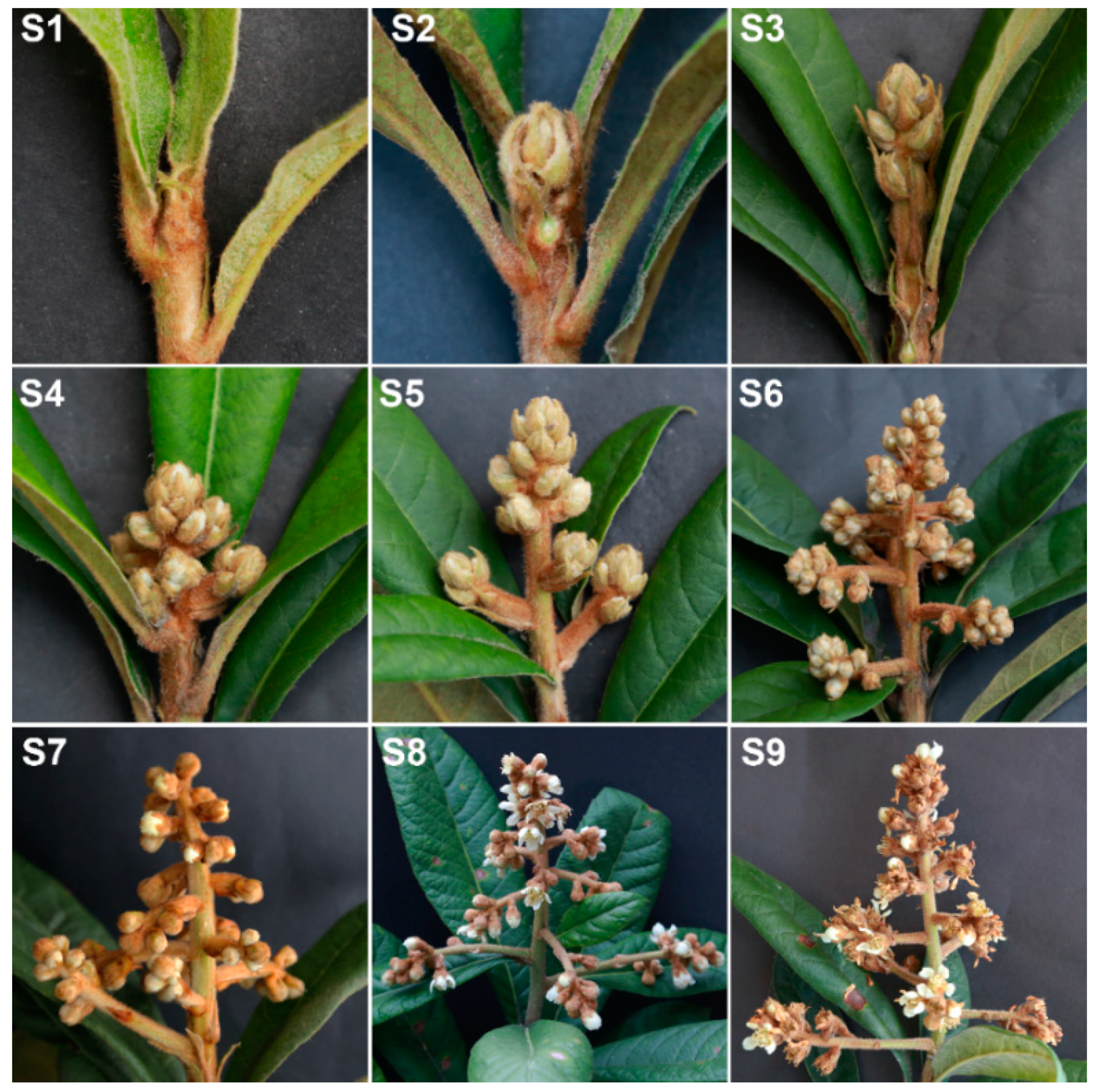

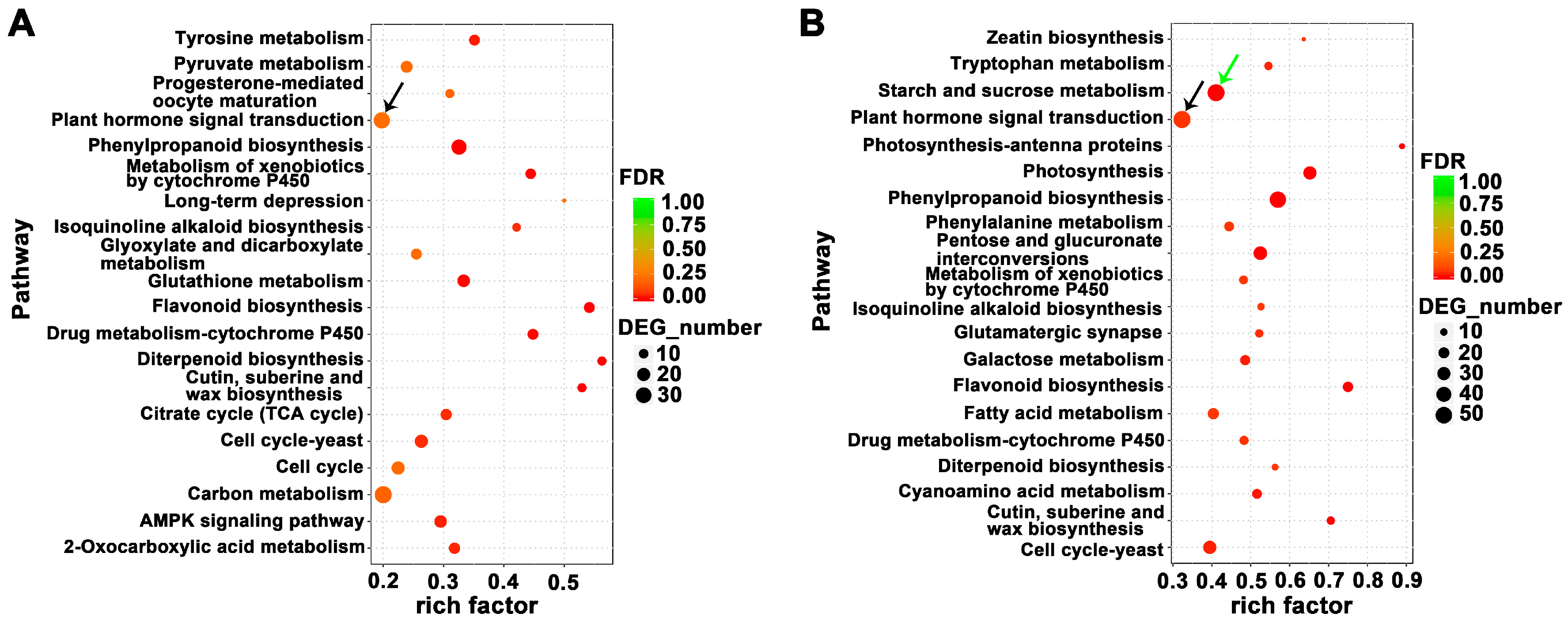


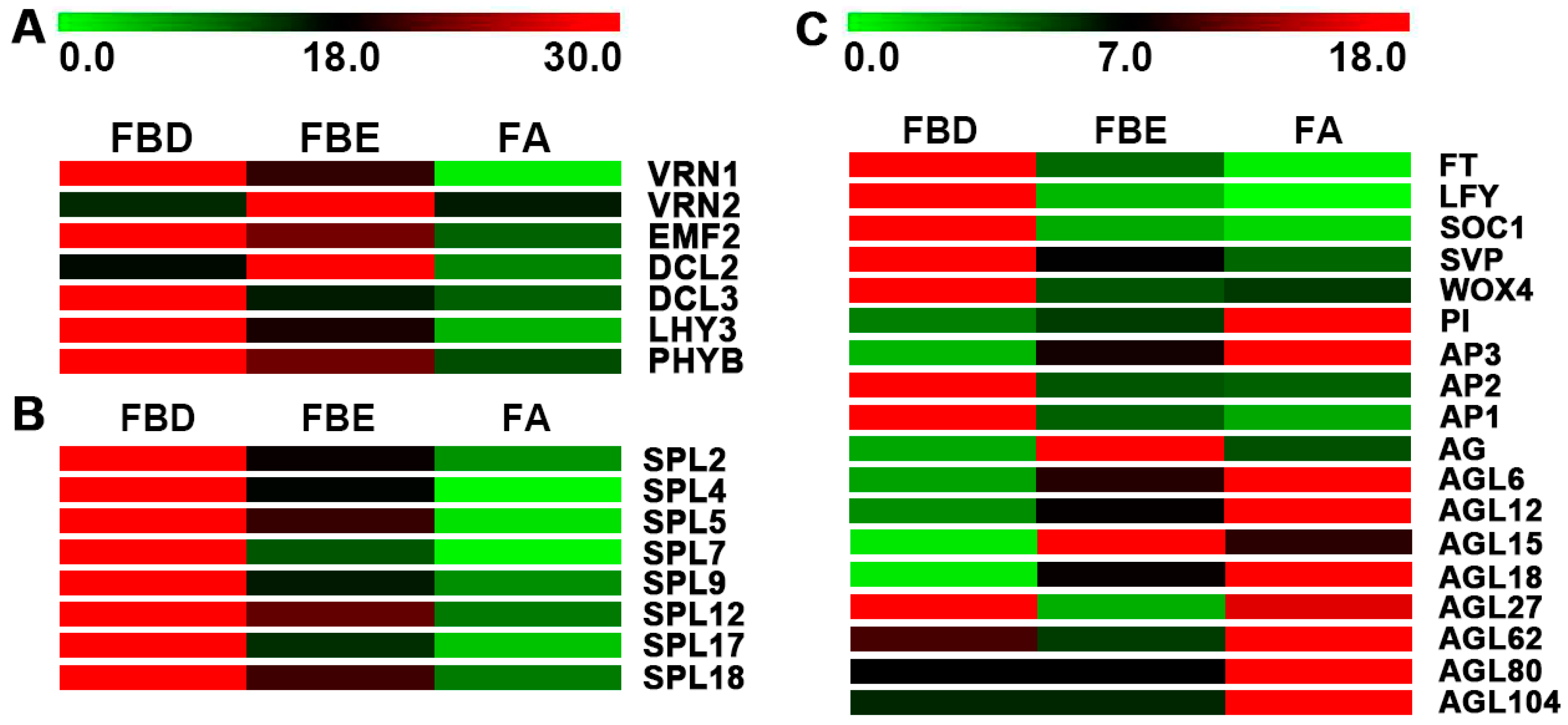
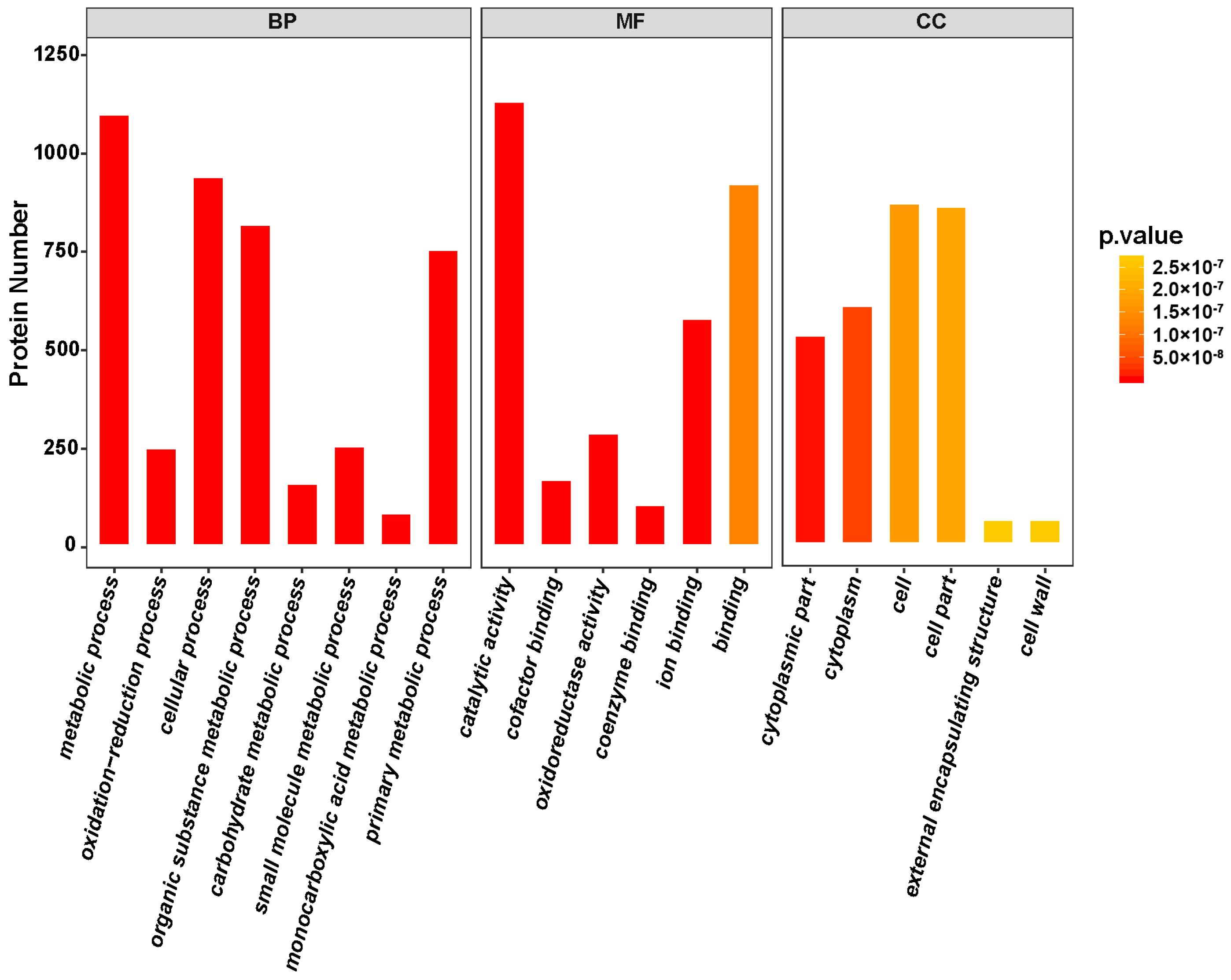
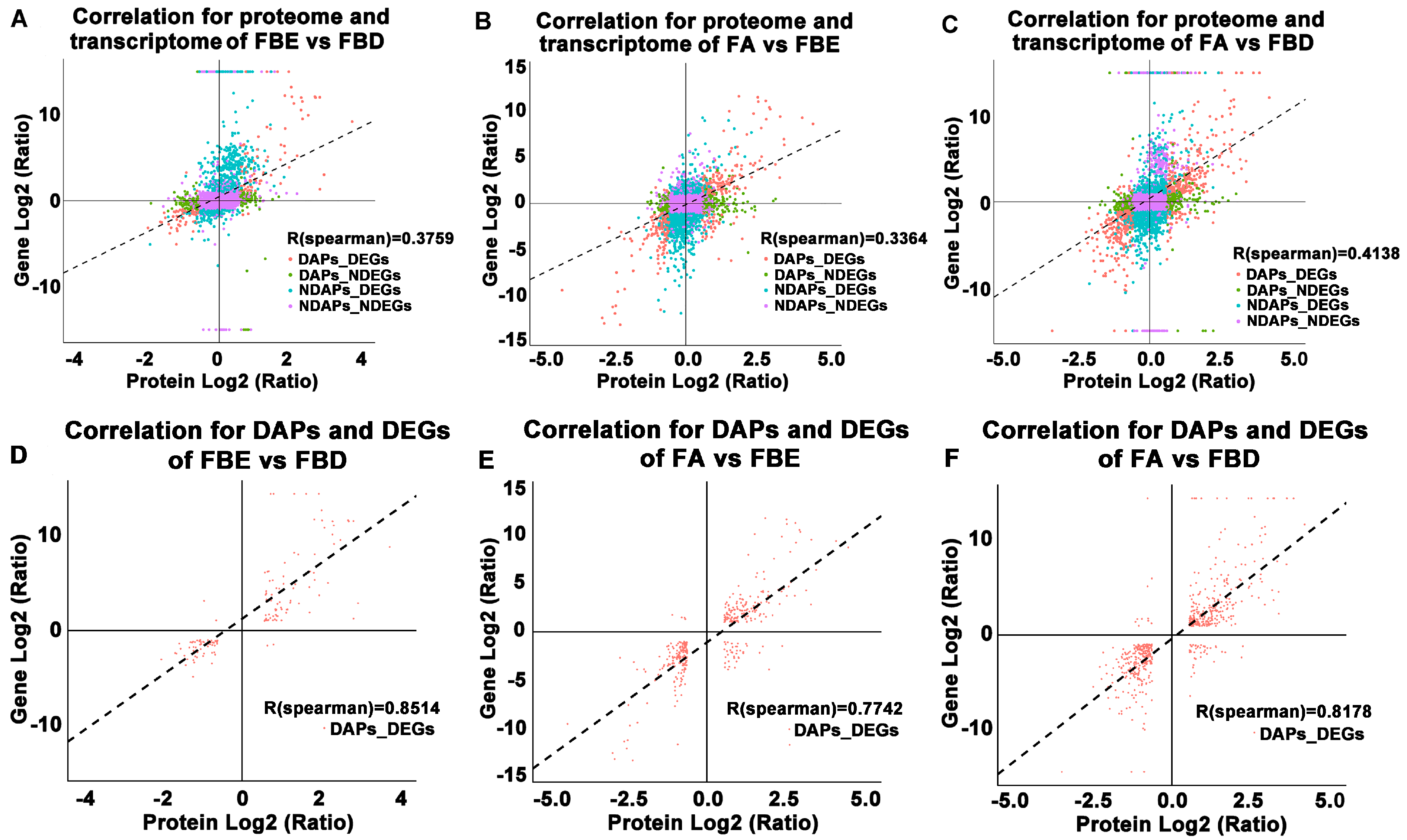



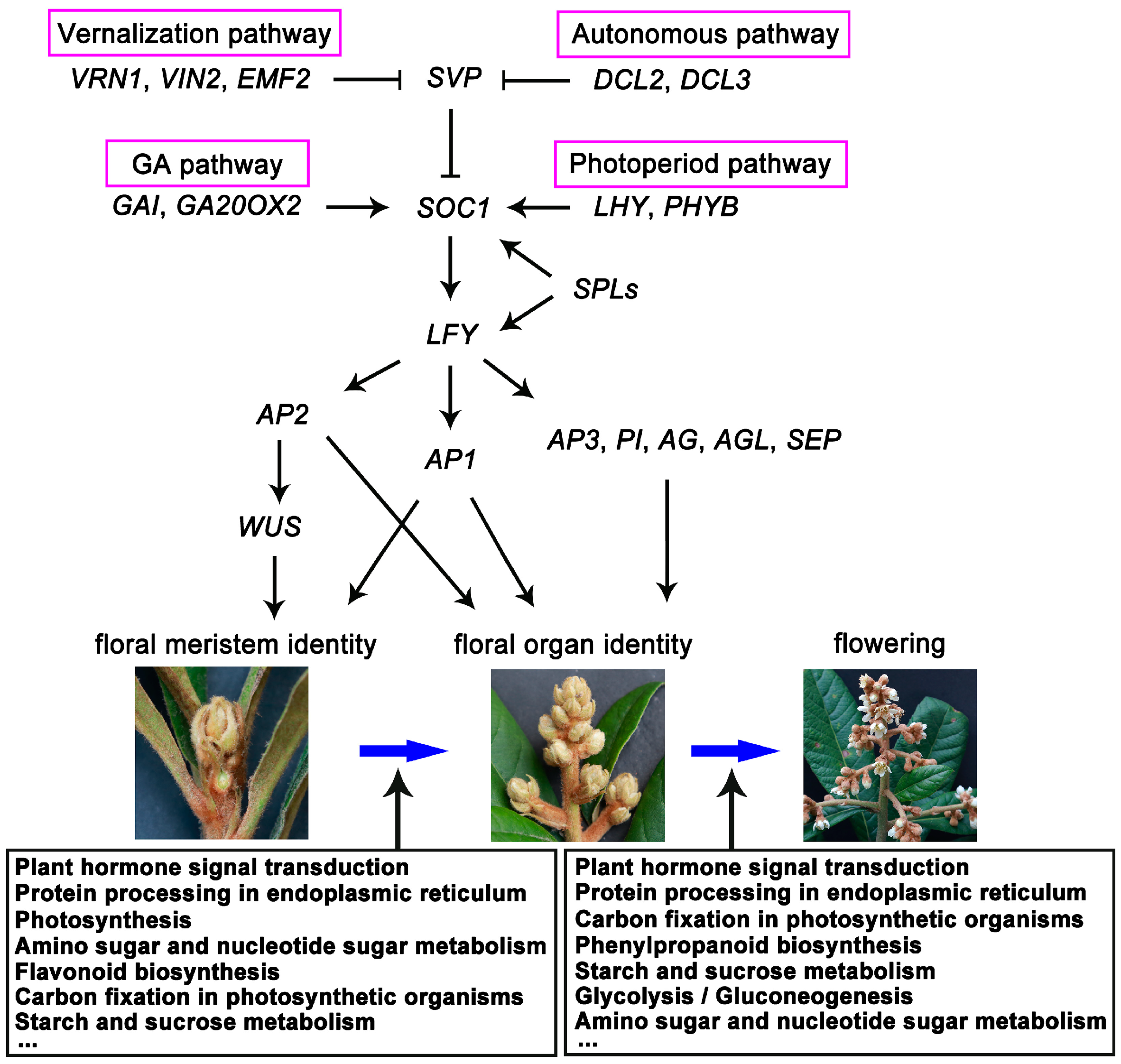
| Gene_ID | Annotation | Fold Change (FBE/FBD) | Fold Change (FA/FBE) | Fold Change (FA/FBD) |
|---|---|---|---|---|
| Auxin signaling pathway | ||||
| DN62407_c0_g2 | Auxin-induced protein 10A5 (A10A5) | 1.50 | 4.88 | 7.35 |
| DN53030_c0_g1 | Indole-3-acetic acid-induced protein ARG7 (ARG7) | 0.83 | 3.35 | 2.77 |
| DN68900_c2_g4 | Auxin-induced protein 6B (AX6B) | 1.23 | 9.02 | 11.11 |
| DN68900_c3_g2 | Auxin-induced protein X10A (AX10A) | 3.43 | 6.90 | 23.65 |
| DN63607_c3_g1 | Auxin-induced protein 15A (AX15A) | 0.14 | 0.39 | 0.05 |
| DN65976_c2_g3 | Auxin-induced protein 22D (AX22D) | 1.21 | 4.76 | 5.74 |
| DN72894_c3_g5 | Indole-3-acetic acid-amido synthetase GH3.6 (GH36) | 0.51 | 1.49 | 0.76 |
| DN39057_c0_g1 | Auxin-responsive protein IAA32 (IAA32) | 1.13 | 7.82 | 8.82 |
| DN63908_c0_g1 | Auxin transporter-like protein 2 (LAX2) | 1.05 | 2.29 | 2.40 |
| DN62802_c0_g1 | Auxin transporter-like protein 3 (LAX3) | 2.77 | 0.85 | 2.37 |
| DN70362_c2_g3 | Auxin-responsive protein SAUR32 (SAU32) | 2.25 | 2.44 | 5.49 |
| DN70025_c0_g2 | Auxin-responsive protein SAUR36 (SAU36) | 1.58 | 5.52 | 8.74 |
| DN70819_c6_g3 | Auxin-responsive protein SAUR50 (SAU50) | 0.42 | 1.07 | 0.45 |
| DN66182_c1_g5 | Auxin-responsive protein SAUR71 (SAU71) | 1.85 | 1.42 | 2.64 |
| GA signaling and metabolism pathway | ||||
| DN62963_c0_g1 | Gibberellin 20 oxidase 1 (GA20OX1) | 13.47 | 2.67 | 35.97 |
| DN69182_c1_g4 | Gibberellin 20 oxidase 2 (GA20OX2) | 0.30 | 0.28 | 0.08 |
| DN70029_c1_g4 | Gibberellic acid-insensitive (GAI) | 0.85 | 0.32 | 0.27 |
| DN53975_c0_g1 | Gibberellin 2-beta-dioxygenase 2 (GA2OX2) | 3.97 | 10.70 | 42.43 |
| DN66786_c1_g1 | Gibberellin 2-beta-dioxygenase 8 (GA2OX8) | 9.42 | 3.48 | 32.78 |
| DN52581_c0_g1 | Gibberellin 3-beta-dioxygenase 1 (GA3OX1) | 0.02 | 0.27 | 0.01 |
| DN65482_c3_g1 | Gibberellin receptor GID1B ( GID1B) | 1.93 | 1.30 | 2.50 |
| Cytokinin signaling pathway | ||||
| DN69821_c1_g5 | Cytokinin oxidase/dehydrogenase 3 (CKX3) | 0.32 | 11.69 | 3.76 |
| DN58587_c0_g1 | Cytokinin oxidase/dehydrogenase 5 (CKX5) | 29.33 | 0.10 | 2.97 |
| DN64500_c1_g3 | Lonely guy 7 (LOG7) | 2.34 | 0.03 | 0.08 |
| DN58587_c0_g1 | Lonely guy 8 (LOG8) | 29.33 | 0.10 | 2.97 |
| Gene_ID | Annotation | Fold Change (FBE/FBD) | Fold Change (FA/FBD) | Fold Change (FA/FBE) |
|---|---|---|---|---|
| Ethylene signaling pathway | ||||
| DN3184_c0_g1 | Ethylene-responsive transcription factor ERF62 (ERF62) | 5.81 | 13.97 | 2.40 |
| DN65937_c1_g5 | Ethylene-responsive transcription factor ERF92 (ERF92) | 2.07 | 3.60 | 1.74 |
| DN65178_c3_g5 | Ethylene-responsive transcription factor ERF106 (ERF106) | 2.60 | 9.34 | 3.60 |
| DN66697_c3_g4 | Ethylene-responsive transcription factor ESR1 (ESR1) | 0.19 | 0.09 | 0.46 |
| ABA signaling pathway | ||||
| DN49553_c0_g1 | Abscisic acid 8’-hydroxylase 2 (ABAH2) | 2.65 | 1.38 | 0.52 |
| DN66767_c1_g1 | Abscisic acid 8’-hydroxylase 4 (ABAH4) | 3.12 | 19.82 | 6.36 |
| DN67864_c2_g4 | Abscisic acid-insensitive 5 (ABI5) | 13.63 | 6.27 | 0.46 |
| DN48609_c0_g1 | Abscisic acid-insensitive 5-like protein 1 (AI5L1) | 2.66 | 0.45 | 0.17 |
| JA signaling pathway | ||||
| DN68639_c0_g1 | Jasmonate O-methyltransferase (JMT) | 7.70 | 61.13 | 7.94 |
| DN65561_c1_g2 | Lipoxygenase 6 (LOX6) | 1.20 | 3.33 | 2.78 |
| DN68565_c0_g4 | Lipoxygenase 15 (LOX15) | 1.50 | 7.72 | 5.14 |
| DN71255_c1_g1 | Lipoxygenase 21 (LOX21) | 1.10 | 0.05 | 0.05 |
| SA signaling pathway | ||||
| DN62662_c1_g1 | Salicylic acid-binding protein 2 (SABP2) | 1.37 | 2.33 | 1.70 |
© 2020 by the authors. Licensee MDPI, Basel, Switzerland. This article is an open access article distributed under the terms and conditions of the Creative Commons Attribution (CC BY) license (http://creativecommons.org/licenses/by/4.0/).
Share and Cite
Jing, D.; Chen, W.; Hu, R.; Zhang, Y.; Xia, Y.; Wang, S.; He, Q.; Guo, Q.; Liang, G. An Integrative Analysis of Transcriptome, Proteome and Hormones Reveals Key Differentially Expressed Genes and Metabolic Pathways Involved in Flower Development in Loquat. Int. J. Mol. Sci. 2020, 21, 5107. https://doi.org/10.3390/ijms21145107
Jing D, Chen W, Hu R, Zhang Y, Xia Y, Wang S, He Q, Guo Q, Liang G. An Integrative Analysis of Transcriptome, Proteome and Hormones Reveals Key Differentially Expressed Genes and Metabolic Pathways Involved in Flower Development in Loquat. International Journal of Molecular Sciences. 2020; 21(14):5107. https://doi.org/10.3390/ijms21145107
Chicago/Turabian StyleJing, Danlong, Weiwei Chen, Ruoqian Hu, Yuchen Zhang, Yan Xia, Shuming Wang, Qiao He, Qigao Guo, and Guolu Liang. 2020. "An Integrative Analysis of Transcriptome, Proteome and Hormones Reveals Key Differentially Expressed Genes and Metabolic Pathways Involved in Flower Development in Loquat" International Journal of Molecular Sciences 21, no. 14: 5107. https://doi.org/10.3390/ijms21145107
APA StyleJing, D., Chen, W., Hu, R., Zhang, Y., Xia, Y., Wang, S., He, Q., Guo, Q., & Liang, G. (2020). An Integrative Analysis of Transcriptome, Proteome and Hormones Reveals Key Differentially Expressed Genes and Metabolic Pathways Involved in Flower Development in Loquat. International Journal of Molecular Sciences, 21(14), 5107. https://doi.org/10.3390/ijms21145107





